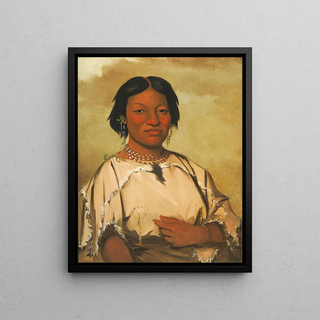Art print | O-je-en-he A woman living in a bear's den - George Catlin


View from behind

Frame (optional)
Art print O-je-en-he A woman living in a bear's den - George Catlin – Captivating introduction
In the fascinating universe of art, some works manage to capture the very essence of a culture, a period, or an individual. "O-je-en-he A woman living in a bear's den - George Catlin" is one of those creations that transcend the simple pictorial frame to immerse us in the world of North American indigenous peoples. This piece, created by painter and ethnographer George Catlin, does not merely depict a woman from the Mandan tribe; it tells a story, evokes traditions, and invites contemplation of a often little-known world. By immersing ourselves in this representation, we feel the intensity of the connection between humans and nature, a bond that Catlin strives to highlight through his art.
Style and uniqueness of the work
Catlin's work stands out for its realistic and poetic approach. In "O-je-en-he," he manages to capture the essence of his subject with remarkable precision, while infusing the image with emotional depth. The woman depicted, dressed in traditional attire, stands proudly in her environment, demonstrating the strength and resilience of indigenous women. The vibrant colors and meticulous details, such as ornaments and facial expressions, reveal Catlin's skill in observing and paying homage to the culture he immortalizes. This painting is not limited to a simple representation; it is an open window to a world rich in customs and stories, where each brushstroke seems to narrate a forgotten legend. The harmony between the subject and the surrounding landscape also reflects the interconnectedness between man and nature, a recurring theme in the artist's work.
The artist and his influence
George Catlin, born in 1796, is often regarded as one of the first artists to document North American indigenous peoples with such passion and dedication. Traveling across the United States, he had the opportunity to meet many tribes, learning their customs and way of life. His work is not only artistic, but

Matte finish

View from behind

Frame (optional)
Art print O-je-en-he A woman living in a bear's den - George Catlin – Captivating introduction
In the fascinating universe of art, some works manage to capture the very essence of a culture, a period, or an individual. "O-je-en-he A woman living in a bear's den - George Catlin" is one of those creations that transcend the simple pictorial frame to immerse us in the world of North American indigenous peoples. This piece, created by painter and ethnographer George Catlin, does not merely depict a woman from the Mandan tribe; it tells a story, evokes traditions, and invites contemplation of a often little-known world. By immersing ourselves in this representation, we feel the intensity of the connection between humans and nature, a bond that Catlin strives to highlight through his art.
Style and uniqueness of the work
Catlin's work stands out for its realistic and poetic approach. In "O-je-en-he," he manages to capture the essence of his subject with remarkable precision, while infusing the image with emotional depth. The woman depicted, dressed in traditional attire, stands proudly in her environment, demonstrating the strength and resilience of indigenous women. The vibrant colors and meticulous details, such as ornaments and facial expressions, reveal Catlin's skill in observing and paying homage to the culture he immortalizes. This painting is not limited to a simple representation; it is an open window to a world rich in customs and stories, where each brushstroke seems to narrate a forgotten legend. The harmony between the subject and the surrounding landscape also reflects the interconnectedness between man and nature, a recurring theme in the artist's work.
The artist and his influence
George Catlin, born in 1796, is often regarded as one of the first artists to document North American indigenous peoples with such passion and dedication. Traveling across the United States, he had the opportunity to meet many tribes, learning their customs and way of life. His work is not only artistic, but






